建筑施工安全性
建筑工程安全的特点
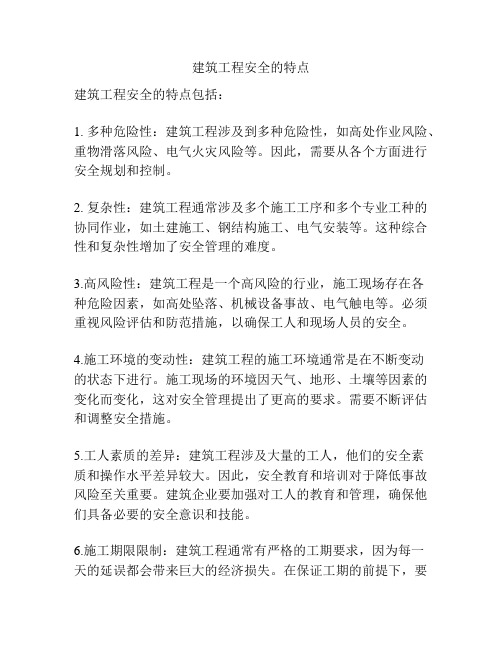
建筑工程安全的特点建筑工程安全的特点包括:1. 多种危险性:建筑工程涉及到多种危险性,如高处作业风险、重物滑落风险、电气火灾风险等。
因此,需要从各个方面进行安全规划和控制。
2. 复杂性:建筑工程通常涉及多个施工工序和多个专业工种的协同作业,如土建施工、钢结构施工、电气安装等。
这种综合性和复杂性增加了安全管理的难度。
3.高风险性:建筑工程是一个高风险的行业,施工现场存在各种危险因素,如高处坠落、机械设备事故、电气触电等。
必须重视风险评估和防范措施,以确保工人和现场人员的安全。
4.施工环境的变动性:建筑工程的施工环境通常是在不断变动的状态下进行。
施工现场的环境因天气、地形、土壤等因素的变化而变化,这对安全管理提出了更高的要求。
需要不断评估和调整安全措施。
5.工人素质的差异:建筑工程涉及大量的工人,他们的安全素质和操作水平差异较大。
因此,安全教育和培训对于降低事故风险至关重要。
建筑企业要加强对工人的教育和管理,确保他们具备必要的安全意识和技能。
6.施工期限限制:建筑工程通常有严格的工期要求,因为每一天的延误都会带来巨大的经济损失。
在保证工期的前提下,要合理规划施工进度,确保安全措施的充分执行,并协调各个施工方的合作,以提高施工期间的安全管理水平。
7. 法律法规的监管:建筑行业受到严格的法律法规监管,涉及建设工程法、劳动法、安全生产法等多个法律法规。
建筑企业需要熟悉并严格遵守相关法律法规,以确保施工过程中的安全合规。
尽管建筑工程安全存在以上的特点,但通过合理的规划、培训和管理,加强预防意识和技术手段,可以有效减少事故风险,保障施工人员的生命安全和财产安全。
建筑施工常见安全隐患

建筑施工常见安全隐患在建筑施工的过程中,由于涉及到众多复杂的工序和人员设备的交互,存在着各种各样的安全隐患。
这些安全隐患不仅可能导致工程延误、成本增加,更严重的是可能威胁到施工人员的生命安全和身体健康。
下面我们就来详细了解一下建筑施工中常见的安全隐患。
一、高处坠落高处坠落是建筑施工中最为常见且后果严重的安全事故之一。
在进行外墙施工、脚手架搭建、塔吊操作等高空作业时,如果没有采取有效的防护措施,如佩戴安全带、设置防护栏等,施工人员一旦失足就很容易从高处坠落。
此外,恶劣的天气条件(如大风、暴雨等)也可能增加高处坠落的风险。
二、物体打击在施工现场,经常会有各种材料、工具、构配件等物体从高处掉落,如果下方有施工人员,就可能造成物体打击事故。
例如,在拆除模板、吊运材料时,如果操作不当或者没有设置警示区域,掉落的物体就可能击中下方人员。
三、坍塌事故坍塌事故主要包括土方坍塌、模板坍塌、脚手架坍塌等。
在进行土方开挖时,如果没有按照规定进行放坡或者支护,就可能导致土方坍塌。
模板和脚手架的搭建如果不符合规范要求,承受不住上部的荷载,也容易发生坍塌事故。
四、机械伤害建筑施工中会使用到各种各样的机械设备,如塔吊、起重机、搅拌机等。
如果操作人员未经培训或违规操作,设备维护保养不到位,就可能导致机械伤害事故。
例如,设备的旋转部件、传动部件可能会绞伤操作人员的肢体,设备的运动部件可能会撞击施工人员。
五、触电事故施工现场临时用电设备众多,如果电线敷设不符合规范,电气设备老化、损坏,或者没有采取有效的接地、接零保护措施,就很容易发生触电事故。
在潮湿的环境中,触电的风险会进一步加大。
六、火灾爆炸建筑施工中会用到大量的易燃、易爆材料,如油漆、涂料、氧气瓶、乙炔瓶等。
如果在储存、使用和运输这些材料的过程中没有遵守相关规定,就可能引发火灾爆炸事故。
此外,施工现场的电气焊作业、明火作业如果没有采取防火措施,也容易引发火灾。
七、中毒窒息在进行地下工程施工、管道施工等作业时,如果通风不良,可能会导致施工人员中毒窒息。
建筑施工安全检查评分计算
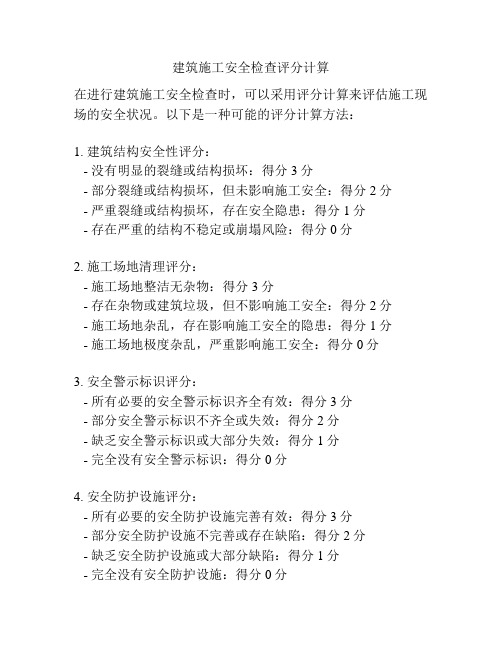
建筑施工安全检查评分计算
在进行建筑施工安全检查时,可以采用评分计算来评估施工现场的安全状况。
以下是一种可能的评分计算方法:
1. 建筑结构安全性评分:
- 没有明显的裂缝或结构损坏:得分3分
- 部分裂缝或结构损坏,但未影响施工安全:得分2分
- 严重裂缝或结构损坏,存在安全隐患:得分1分
- 存在严重的结构不稳定或崩塌风险:得分0分
2. 施工场地清理评分:
- 施工场地整洁无杂物:得分3分
- 存在杂物或建筑垃圾,但不影响施工安全:得分2分
- 施工场地杂乱,存在影响施工安全的隐患:得分1分
- 施工场地极度杂乱,严重影响施工安全:得分0分
3. 安全警示标识评分:
- 所有必要的安全警示标识齐全有效:得分3分
- 部分安全警示标识不齐全或失效:得分2分
- 缺乏安全警示标识或大部分失效:得分1分
- 完全没有安全警示标识:得分0分
4. 安全防护设施评分:
- 所有必要的安全防护设施完善有效:得分3分
- 部分安全防护设施不完善或存在缺陷:得分2分
- 缺乏安全防护设施或大部分缺陷:得分1分
- 完全没有安全防护设施:得分0分
5. 施工人员文明施工评分:
- 所有施工人员文明施工,遵守安全规章制度:得分3分
- 部分施工人员存在文明施工问题:得分2分
- 大部分施工人员存在文明施工问题:得分1分
- 施工人员严重违反安全规章制度:得分0分
根据以上评分标准,对每一项进行评分,最后将各项得分相加,即可得到整体的建筑施工安全检查评分。
评分越高,代表施工现场的安全状况越好,评分越低则代表存在更多的安全隐患。
建筑施工现场存在的安全和环保问题及其对策
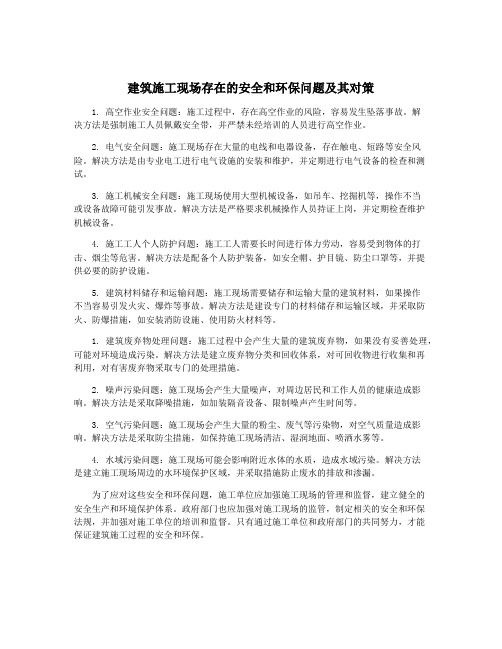
建筑施工现场存在的安全和环保问题及其对策1. 高空作业安全问题:施工过程中,存在高空作业的风险,容易发生坠落事故。
解决方法是强制施工人员佩戴安全带,并严禁未经培训的人员进行高空作业。
2. 电气安全问题:施工现场存在大量的电线和电器设备,存在触电、短路等安全风险。
解决方法是由专业电工进行电气设施的安装和维护,并定期进行电气设备的检查和测试。
3. 施工机械安全问题:施工现场使用大型机械设备,如吊车、挖掘机等,操作不当或设备故障可能引发事故。
解决方法是严格要求机械操作人员持证上岗,并定期检查维护机械设备。
4. 施工工人个人防护问题:施工工人需要长时间进行体力劳动,容易受到物体的打击、烟尘等危害。
解决方法是配备个人防护装备,如安全帽、护目镜、防尘口罩等,并提供必要的防护设施。
5. 建筑材料储存和运输问题:施工现场需要储存和运输大量的建筑材料,如果操作不当容易引发火灾、爆炸等事故。
解决方法是建设专门的材料储存和运输区域,并采取防火、防爆措施,如安装消防设施、使用防火材料等。
1. 建筑废弃物处理问题:施工过程中会产生大量的建筑废弃物,如果没有妥善处理,可能对环境造成污染。
解决方法是建立废弃物分类和回收体系,对可回收物进行收集和再利用,对有害废弃物采取专门的处理措施。
2. 噪声污染问题:施工现场会产生大量噪声,对周边居民和工作人员的健康造成影响。
解决方法是采取降噪措施,如加装隔音设备、限制噪声产生时间等。
3. 空气污染问题:施工现场会产生大量的粉尘、废气等污染物,对空气质量造成影响。
解决方法是采取防尘措施,如保持施工现场清洁、湿润地面、喷洒水雾等。
4. 水域污染问题:施工现场可能会影响附近水体的水质,造成水域污染。
解决方法是建立施工现场周边的水环境保护区域,并采取措施防止废水的排放和渗漏。
为了应对这些安全和环保问题,施工单位应加强施工现场的管理和监督,建立健全的安全生产和环境保护体系。
政府部门也应加强对施工现场的监管,制定相关的安全和环保法规,并加强对施工单位的培训和监督。
建筑工程施工中的常见安全隐患有哪些

建筑工程施工中的常见安全隐患有哪些建筑工程施工是一个复杂且充满风险的过程,涉及到众多的人员、设备和操作环节。
在这个过程中,存在着各种各样的安全隐患,如果不加以重视和及时排除,可能会导致严重的人员伤亡和财产损失。
以下是建筑工程施工中一些常见的安全隐患:一、高处坠落高处坠落是建筑施工中最常见的安全事故之一。
在建筑物的外墙施工、脚手架搭建与拆除、吊篮作业、屋顶作业等环节,如果没有采取有效的防护措施,如佩戴安全带、设置防护栏杆和安全网等,工人很容易从高处坠落。
此外,恶劣的天气条件(如大风、暴雨)也可能增加高处坠落的风险。
二、物体打击物体打击事故通常是由于施工现场的物料、工具、构配件等从高处掉落,击中下方的人员造成伤害。
例如,在塔吊吊运材料时,如果捆绑不牢固或者吊运过程中出现故障,材料可能会掉落;在拆除模板、脚手架时,拆下的杆件、扣件等如果随意抛掷,也可能会砸到周围的人员。
三、坍塌事故坍塌事故在建筑施工中具有极大的破坏性。
主要包括土方坍塌、模板坍塌、脚手架坍塌和建筑物坍塌等。
土方工程中,如果没有按照规范进行放坡或支护,或者在雨天施工时没有采取有效的排水措施,都可能导致土方坍塌。
模板和脚手架的搭设如果不符合设计要求,使用了劣质的材料,或者在施工过程中违规拆除支撑结构,也容易引发坍塌事故。
建筑物坍塌则往往是由于结构设计不合理、施工质量差或者在拆除过程中操作不当等原因造成的。
四、机械伤害建筑施工现场使用的各种机械设备,如塔吊、起重机、搅拌机、电锯等,如果操作人员未经培训或违规操作,设备缺乏维护保养或存在故障,都可能导致机械伤害事故。
例如,操作人员在操作塔吊时,如果没有看清吊运路线上的障碍物或人员,可能会造成碰撞伤害;电锯在运转时,如果操作人员没有正确佩戴防护用品,手部可能会被锯伤。
五、触电事故施工现场临时用电存在着较多的安全隐患。
电线私拉乱接、电线老化破损、配电箱不符合规范要求、用电设备没有接地或接零保护等情况都可能导致触电事故的发生。
建筑施工安全管理的特点
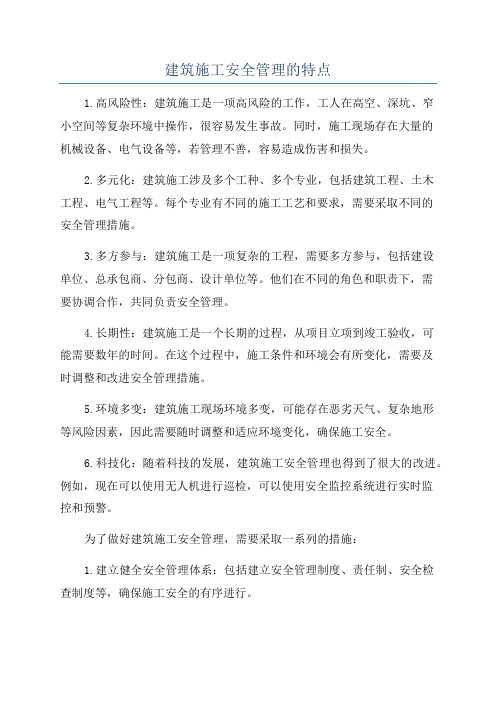
建筑施工安全管理的特点1.高风险性:建筑施工是一项高风险的工作,工人在高空、深坑、窄小空间等复杂环境中操作,很容易发生事故。
同时,施工现场存在大量的机械设备、电气设备等,若管理不善,容易造成伤害和损失。
2.多元化:建筑施工涉及多个工种、多个专业,包括建筑工程、土木工程、电气工程等。
每个专业有不同的施工工艺和要求,需要采取不同的安全管理措施。
3.多方参与:建筑施工是一项复杂的工程,需要多方参与,包括建设单位、总承包商、分包商、设计单位等。
他们在不同的角色和职责下,需要协调合作,共同负责安全管理。
4.长期性:建筑施工是一个长期的过程,从项目立项到竣工验收,可能需要数年的时间。
在这个过程中,施工条件和环境会有所变化,需要及时调整和改进安全管理措施。
5.环境多变:建筑施工现场环境多变,可能存在恶劣天气、复杂地形等风险因素,因此需要随时调整和适应环境变化,确保施工安全。
6.科技化:随着科技的发展,建筑施工安全管理也得到了很大的改进。
例如,现在可以使用无人机进行巡检,可以使用安全监控系统进行实时监控和预警。
为了做好建筑施工安全管理,需要采取一系列的措施:1.建立健全安全管理体系:包括建立安全管理制度、责任制、安全检查制度等,确保施工安全的有序进行。
2.加强安全宣传教育:通过开展安全培训、安全知识宣传等活动,提高工人的安全意识和技能。
3.严格施工许可控制:对进入施工现场的人员、车辆等进行严格的管理和控制,确保施工现场的安全。
4.安全设施和装备:为施工现场配备必要的安全设施和装备,例如安全帽、安全防护网、安全绳等,确保施工人员的人身安全。
5.定期检查和监控:定期对施工现场进行安全检查和监控,发现隐患及时处理,确保施工安全。
6.加强协作与沟通:建设单位、总承包商、分包商、设计单位等各方之间加强沟通和协作,共同负责施工安全。
总的来说,建筑施工安全管理是一项复杂而又重要的工作,需要多方共同努力,充分发挥各方的职责和作用,确保施工现场的安全。
建筑施工企业安全生产特点
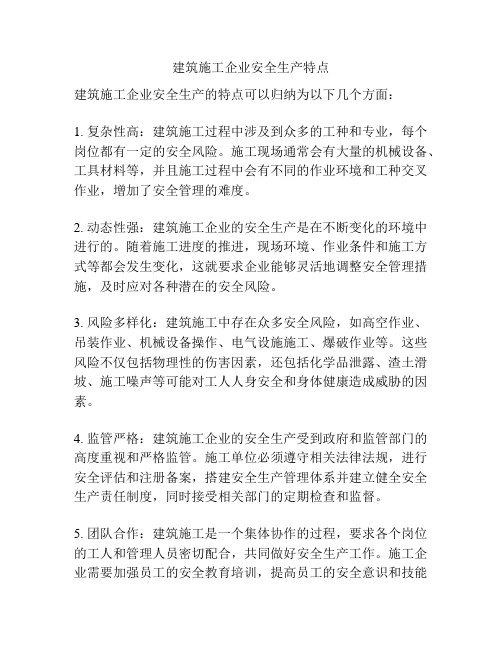
建筑施工企业安全生产特点
建筑施工企业安全生产的特点可以归纳为以下几个方面:
1. 复杂性高:建筑施工过程中涉及到众多的工种和专业,每个岗位都有一定的安全风险。
施工现场通常会有大量的机械设备、工具材料等,并且施工过程中会有不同的作业环境和工种交叉作业,增加了安全管理的难度。
2. 动态性强:建筑施工企业的安全生产是在不断变化的环境中进行的。
随着施工进度的推进,现场环境、作业条件和施工方式等都会发生变化,这就要求企业能够灵活地调整安全管理措施,及时应对各种潜在的安全风险。
3. 风险多样化:建筑施工中存在众多安全风险,如高空作业、吊装作业、机械设备操作、电气设施施工、爆破作业等。
这些风险不仅包括物理性的伤害因素,还包括化学品泄露、渣土滑坡、施工噪声等可能对工人人身安全和身体健康造成威胁的因素。
4. 监管严格:建筑施工企业的安全生产受到政府和监管部门的高度重视和严格监管。
施工单位必须遵守相关法律法规,进行安全评估和注册备案,搭建安全生产管理体系并建立健全安全生产责任制度,同时接受相关部门的定期检查和监督。
5. 团队合作:建筑施工是一个集体协作的过程,要求各个岗位的工人和管理人员密切配合,共同做好安全生产工作。
施工企业需要加强员工的安全教育培训,提高员工的安全意识和技能
水平,使每个人都能够自觉地遵守安全操作规程,减少事故发生的可能性。
除了以上特点之外,建筑施工企业的安全生产还面临着其他挑战,如施工工期紧张、施工现场复杂多变、人力资源短缺等。
因此,建筑施工企业需要加强安全管理,制定科学合理的安全措施,提高安全生产管理水平,确保施工过程中不发生安全事故,保障工人的安全和身体健康。
建筑工程中的建筑施工与安全

建筑工程中的建筑施工与安全在建筑工程中,建筑施工与安全是两个不可分割的关键要素。
建筑施工的质量和安全直接影响着工程的顺利进行和建筑物的使用安全。
本文将就建筑工程中建筑施工和安全的重要性、安全管理的措施以及优化施工流程提出一些看法。
一、建筑施工的重要性建筑施工是建筑项目完成的关键环节,它直接关系到建筑质量、工程进度和安全性。
在建筑施工中,施工方需要根据设计图纸进行具体的实施,并且要确保施工过程的协调和合理性。
只有建筑施工达到了预期的要求,才能保证项目成功交付和建筑物可持续使用。
建筑施工的关键任务包括但不限于以下几个方面:1. 准备工作:施工前的准备工作非常重要,包括场地清理、材料采购、施工机械的调试等。
准备工作的做好程度将直接影响施工的顺利进行。
2. 施工质量:建筑施工需要按照设计图纸和相关规范进行,保证施工质量符合标准要求。
施工质量的好坏将直接决定着建筑物的使用寿命和安全性能。
3. 工程进度:在建筑施工中,工程进度的控制十分重要。
施工方需要合理安排施工进度,确保按时完成各项工作,以保证整个工程按计划进行。
4. 与其他工种的协调:建筑施工涉及到多个工种的协同作业,施工方需要与其他工种保持密切的沟通协调,确保各个工种的工作有条不紊进行。
综上所述,建筑施工是建筑工程中不可或缺的一部分,合理高效地开展施工工作对于保证工程质量和建筑物的安全具有至关重要的作用。
二、安全管理措施建筑工程中的安全管理是为了防范施工过程中可能发生的安全事故,保障工人的安全和身体健康。
安全管理措施包括但不限于以下几个方面:1.人员培训:施工单位应当组织施工人员进行相关的安全培训,使他们了解安全操作规范、危险品使用和事故应急处理等知识,提高工人的安全意识。
2.安全设施:在施工现场,应该设置警示标识、安全网、安全防护栏等安全设施,确保工人在施工过程中的安全。
3.定期检查:施工单位应当定期对施工现场进行安全检查,及时发现和整改存在的安全隐患,做到事故预防和事故处理措施同时进行,确保施工现场的安全。
- 1、下载文档前请自行甄别文档内容的完整性,平台不提供额外的编辑、内容补充、找答案等附加服务。
- 2、"仅部分预览"的文档,不可在线预览部分如存在完整性等问题,可反馈申请退款(可完整预览的文档不适用该条件!)。
- 3、如文档侵犯您的权益,请联系客服反馈,我们会尽快为您处理(人工客服工作时间:9:00-18:30)。
摘要随着我国经济的迅速发展,我国的建筑行业也迎来了发展的黄金时期。
建筑行业在高速发展的同时,由于本身具有流动性大、高处和露天作业多等特点,属于伤亡事故高危行业,安全形势十分严峻。
如何保障和提高建筑施工现场的安全性是建筑安全中的重要研究课题。
本论文在深入调查国内外建筑安全管理现状的基础上,对建筑安全涉及的主要问题进行了较为深入的研究,用事故树分析法对建筑施工进行危险源辨识,主要以脚手架高处坠落事故和塔吊伤害事故为例,用事故树分析方法分析了事故发生的模式、预防的关键环节及影响事故发生的主要因素。
吸取了事故树分析法(FTA)及作业条件危险性法(LEC)的优势,建立了以模糊综合评判法(FCE)为主体,将三者有机结合起来的建筑施工安全评价方法——FTA-LEC-FCE 评价法,从而有效地对建筑施工安全状况进行整体评价,达到预测、预防的目的。
关键词:建筑施工;事故树;FTA-LEC-FCE 评价法。
AbstractWith the rapid development of economy of our country,China's construction industry has also ushered in a golden development period. With the high-speed development, because of their mobility, height operation and open-air operation,construction industry belongs to high-risk industry, and the security situation is very grim. How to protect and improve construction site safety is an important research topic in building security.Based on the depth investigation on building construction at home and abroad,some questions of construction safety were analyzed. And the achievements are as follows:(1)This paper identifies the hazard of construction with the Fault Tree Analysis .This paper analyzes the patterns of how accidents happen, the key links of the prevention work and the main elements which effect how the accidents happen with the Fault Tree Analysis after researching the falling from scaffolding and crane injury.(2)The FTA-LEC-FCE evaluation was established, after utilizing the advantages of the Fault Tree Analysis and the LEC evaluation. The FTA-LEC-FCE evaluation is the organic combination of the three ones and main part is the fuzzy comprehensive evaluation. The FTA-LEC-FCE evaluation model was used to evaluate the state of the construction safety of the building, the purpose is anticipation and prevention.Key words:construction , fault tree analysis, FTA-LEC-FCE evaluation.目录第一章绪论 ················································································ - 1 -1.1 论文背景 ············································································· - 1 -1.2 国内外建筑安全管理研究现状 ·········································· - 2 -1.2.1 建筑施工的特点 (2)1.2.2 国外安全管理研究状况 (2)1.2.3 国内安全管理研究状况 (3)1.3 国内外安全评价研究与发展 (5)1.3.1 国外安全评价研究与发展 (5)1.3.2 国内安全评价研究与发展 (6)1.4 课题研究的目的及意义 (7)1.4.1 研究的目的 (7)1.4.2 研究的意义 (8)1.5 课题研究的内容及技术路线 (9)1.5.1 研究的内容 (9)1.5.2 研究的技术路线 (11)第二章安全评价 (12)2.1 安全评价的定义 (12)2.2 安全评价的目的 (12)2.3 安全评价程序 (12)2.4 安全评价的分类 (14)2.5 现行安全评价方法 (14)第三章危险源的辨识 (18)3.1 危险源的概念 (18)3.2 危险源的分类 (18)3.2.1 第一类危险源 (18)3.2.2 第二类危险源 (19)3.3 危险源识别的方法 (19)3.4 建筑施工危险源的确定 (21)3.5 事故树分析在建筑施工的应用研究 (23)3.5.1 脚手架处高处坠落事故树分析 (24)3.5.2 塔吊伤害事故树分析 (27)第四章建筑施工安全评价方法的研究 (36)4.1 FTA-LEC-FCE 评价法的建立 (36)4.1.1 模糊数学评判概述 (36)4.1.2 FTA、LEC、FCE 结合的可行性分析 (37)4.2 FTA-LEC-FCE 评价模型的建立 (38)4.2.1 评价指标体系的建立 (38)4.2.2 用LEC 分析法确定评价指标的权重 (39)4.2.3 FTA-LEC-FCE 评价模型的建立 (39)第五章FTA-LEC-FCE 评价法的应用 (39)5.1 工程概况 (39)5.2 FTA-LEC-FCE 评价模型的建立 (43)5.2.1 用LEC法计算指标权重 (43)5.2.2 FTA-LEC-FCE评价体系 (46)5.3 FTA-LEC-FCE 评价模型的计算 (47)5.3.1 初级层次的综合评价 (47)5.3.2 二级层次的综合评价 (48)5.3.3 三级层次的综合评价 (49)5.3.4 等级参数评价 (50)第六章结论与展望 (51)6.1 结论 (51)6.2 展望 (51)参考文献 (53)致谢 (56)第一章绪论1.1 论文背景目前,我国正在进行历史上也是世界上规模最大的基本建设。
每年我国基本建设投入约占国民生产总值的15%左右。
2010 年,建筑业从业人数达到3099.92万人,约占全国工业企业总从业人员的三分之一强,建筑企业数量已经接近7 万家,建筑业总产值达到40552.10 亿元[1]。
工程建设的巨大投入和从业人员的规模使得安全事故造成的后果十分严重,损失也十分巨大,每年由于安全事故而丧生的从业人员达千人,直接经济损失逾百亿[2]。
较低的安全生产管理水平已成为阻碍国家经济建设和社会稳定发展的重要因素,成为全社会关注的焦点。
“安全第一,预防为主”是指导我国安全生产的一项基本国策,我国政府各级领导历来都十分重视安全生产问题,政府有关部门也采取了不少的对策和措施,投入了大量的人力、财力、物力用于安全管理。
但是,这些对策和措施,都不能有效遏制安全事故的频繁发生,这不能不引起我们对我国目前所采取的安全生产管理体系进行深刻反思。
